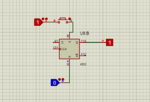aliahsan951
Junior Member level 3

i am making a tic tac toe project using logic gates........ and there i have to use 74174.....? share your thoughts on how it works
Follow along with the video below to see how to install our site as a web app on your home screen.
Note: This feature may not be available in some browsers.









74xxx is old fashioned TTL that uses a high supply current all the time even when it is not doing anything. I stopped using TTL about 38 years ago and have used CD4xxx and 74HCxxx Cmos logic ICs ever since.
I would use an SN74HC174 to replace an old 74174.


now what should i do with rest of D,clk pins....should i connect to input...

You do not need to create a high-frequency clock. Experiment to find out which voltage to apply (high or low) to each terminals, so that the flip-flop works properly.
You should add a pullup (or pulldown) resistor to whichever terminal has the momentary switch.
i am making a tic tac toe game using digital logic. the players will input using push buttons. for this i have to save the inputs for further usage.. as push buttons has momentary output..... so for that i am using d-flip flop......now when i give output of push button to set of flip-flop, it saves the output.... reset (r) is normally grounded. when i need to reset.....i give it positive toHI,
A general rule: "Don´t leave (unused) inputs floating."
The schematic in post#6 leaves
* D floating
* CLK floating
* S floating when the button is not pressed.
You need to give valid input levels. Either HIGH or LOW.
You need to clearely define your desired function. I recommend to read about some basic logic functions.
There are diagrams that show a function with a timing.
There are functional charts, like truth tables.
They make sense, because textual descriptions mostly are ambiguous.
***
About your circuit/function of post#6:
A SET function wihtout any RESET function makes no sense. You didn´t define when/how to RESET the output.
Klaus

In a real circuit this will not work.flip flop is working properly in proteus software without giving any inputs

should i check and confirm it practically before pcb designing
this circuit is using almost 30 to 45 ICs.......(combining logic gates and flip flops) i am using 4 external voltage sources

I'll bet at least one student is using 9 IC's. Two ff per square. One ff lights a red led, another lights a green led. Call one X, call the other O. It's just a different approach.

What exactly you don't understand?i didn't get what you want to say



i am using this oneYou are mixing old fashioned high input current 74174 TTL with completely different CD4013 low output current Cmos.
A 0.5mA output low of a 4013 cannot drive a 1.6mA input of the 74174.
A 2.4V TTL high cannot make a 3.5V Cmos high.
You said you are using the Cmos version then why did you talk about the old TTL version, BROTHER? (I have a sister but not a brother)


i didn't understand what you want to say